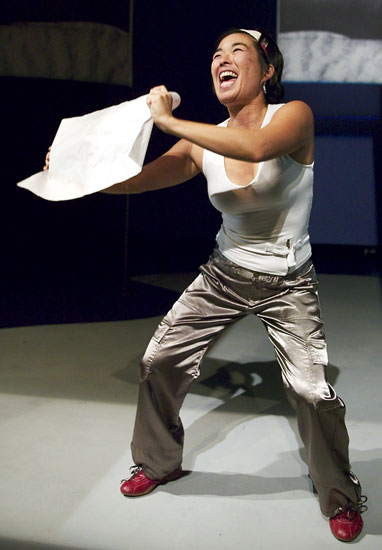Project addresses mistranslation

Graduate student Denise Uyehara’s performance installation, “The Senkotsu (Mis)translation Project,” will premiere on Friday at the Highways Performance Space.
By Jennifer Ta
May 5, 2009 9:13 p.m.
Mistranslation.
It’s something that is happening all around us, whether it be on a humorous level, such as during a game of telephone, or on a much more serious level, a message so deep and complicated that distorts the moment it hits the world.
It is this distortion that Denise Uyehara, a world arts and cultures graduate student at UCLA, focuses on in her performance installation, “The Senkotsu (Mis)translation Project,” premiering this Friday at Santa Monica’s Highways Performance Space.
“It is a project that invites (the) audience to participate in a larger pluralistic set of voices,” Uyehara said. “It is a response to U.S. occupation in Okinawa during World War II. The U.S. has a very large presence in Okinawa.”
The idea for the project came to Uyehara after her visit to Okinawa during the summer of 2003.
“When I traveled into Okinawa, I felt a profound sense of contradiction with the U.S. in the islands of Okinawa,” Uyehara said. “I came back with more questions than answers.”
Uyehara went to work on her project the moment she came back from her trip.
“It went through many coronations,” Uyehara said. “It was originally a different piece that I worked on with another visual artist, Yoshiko Shimada.”
Two years later, in 2005, Uyehara was awarded the prestigious City of Los Angeles Fellowship to develop her project. The fellowship is offered to an individual artist only once in his or her lifetime to develop visual and performance art. With this fellowship, Uyehara continued to develop the project into what it is now.
“This (West Coast premiere) is actually the whole vision of what I wanted to do,” Uyehara said. “The audience walks through a labyrinth of artifacts which they get to interact with as well as (interact with the) creatures (played by other performers) in the show.”
The audience will also be able to pick up a bone at the beginning of the performance, which it will use throughout the performance. For example, there the audience will play “the bone game,” where it can reshape bone pieces into a childhood memory. These games aim to show the traditions of Okinawa culture, demonstrating the Okinawa traditional bone-washing burial ritual called senkotsu.
Audiences can also speak to their bone through a mistranslation device in the shape of a horn, which will translate the message to the bone.
“The message may be translated correctly or mistranslated,” Uyehara said. “I’m using this as a metaphor for how our well-intentions can get mistranslated when we speak it to the world. After all, why should our message be the clearest one?”
Guiding the audience through this installation show will be Uyehara and her ensemble consisting of other performance artists.
Pete Lee is one of the performers.
“I’ve known Denise for years, and we collaborated on other projects,” he said. “I heard about this project when she was awarded the COLA award. She invited me to be a part of it.”
Throughout the performance, Lee will be cooking a traditional dish called “goya champuru,” a mixed-up scrabbled egg dish with bitter melon.
“Denise uses the idea of a bitter melon as part of the show and this is a kind of a country home-style dish,” Lee said.
The dish will also be served with a traditional Okinawa alcoholic drink.
Though Lee will be cooking, he still will be joining the other performers during the show. All performers will have their faces painted white as they dance in a traditional Japanese ghost-like dance called Butoh. Uyehara also incorporated original movements that the performers came up with themselves.
“(The project) is about bringing a lot of different arts together and involving a lot of people,” said Joyce Lu, another performer. “(We) don’t really play characters necessarily. We’re there to support the text through movement and other kinds of improv. We’re like moving sculpture in the art installation.”
Aiding the performers in their dance will be live Okinawa sanshin music performed by artists from the Okinawa Association. Students from UC Irvine will also act as guides throughout the show to help the audience through the various installations.
After showing at the Highways Performance Space, “The Senkotsu (Mis)translation Project” will move to Tucson, Ariz. to be performed in September.
Wherever her project is being shown, Uyehara only hopes to spread her message to the audience.
“I like people to come away asking themselves how we as Americans can help ourselves instead of giving answers to the rest of the world on how to create peace in this time of war,” Uyehara said. “I also want people to come and play the games, have food and a little bit of drink and just enjoy our time together.”

